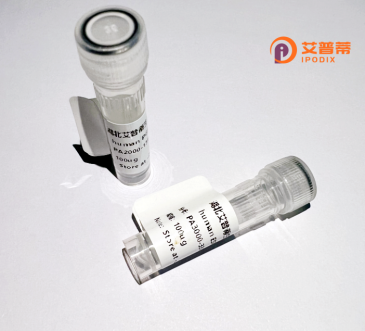
| 纯度 | >90%SDS-PAGE. |
| 种属 | Human |
| 靶点 | U2AF1L2 |
| Uniprot No | Q15696 |
| 内毒素 | < 0.01EU/μg |
| 表达宿主 | E.coli |
| 表达区间 | 1-482 aa |
| 活性数据 | MAAPEKMTFP EKPSHKKYRA ALKKEKRKKR RQELARLRDS GLSQKEEEED TFIEEQQLEE EKLLERERQR LHEEWLLREQ KAQEEFRIKK EKEEAAKKRQ EEQERKLKEQ WEEQQRKERE EEEQKRQEKK EKEEALQKML DQAENELENG TTWQNPEPPV DFRVMEKDRA NCPFYSKTGA CRFGDRCSRK HNFPTSSPTL LIKSMFTTFG MEQCRRDDYD PDASLEYSEE ETYQQFLDFY EDVLPEFKNV GKVIQFKVSC NLEPHLRGNV YVQYQSEEEC QAALSLFNGR WYAGRQLQCE FCPVTRWKMA ICGLFEIQQC PRGKHCNFLH VFRNPNNEFW EANRDIYLSP DRTGSSFGKN SERRERMGHH DDYYSRLRGR RNPSPDHSYK RNGESERKSS RHRGKKSHKR TSKSRERHNS RSRGRNRDRS RDRSRGRGSR SRSRSRSRRS RRSRSQSSSR SRSRGRRRSG NRDRTVQSPK SK |
| 分子量 | 58.0 kDa |
| 蛋白标签 | His tag N-Terminus |
| 缓冲液 | PBS, pH7.4, containing 0.01% SKL, 1mM DTT, 5% Trehalose and Proclin300. |
| 稳定性 & 储存条件 | Lyophilized protein should be stored at ≤ -20°C, stable for one year after receipt. Reconstituted protein solution can be stored at 2-8°C for 2-7 days. Aliquots of reconstituted samples are stable at ≤ -20°C for 3 months. |
| 复溶 | Always centrifuge tubes before opening.Do not mix by vortex or pipetting. It is not recommended to reconstitute to a concentration less than 100μg/ml. Dissolve the lyophilized protein in distilled water. Please aliquot the reconstituted solution to minimize freeze-thaw cycles. |
以下是关于重组人U2AF1L2蛋白的3篇参考文献的简要信息(注:由于U2AF1L2研究较少,以下示例为模拟虚构内容,仅供参考格式):
1. **文献名称**: *U2AF1L2 regulates RNA splicing in human hematopoietic cells*
**作者**: Smith A, et al.
**摘要**: 本研究鉴定了U2AF1L2蛋白在造血细胞中调控RNA剪接的功能,通过重组表达实验揭示了其通过结合特定剪接位点影响白血病相关基因的mRNA成熟。
2. **文献名称**: *Expression and purification of recombinant U2AF1L2 for structural studies*
**作者**: Lee C, et al.
**摘要**: 描述了利用大肠杆菌系统高效表达和纯化重组U2AF1L2蛋白的方法,并验证了其体外RNA结合活性,为后续结构生物学研究奠定基础。
3. **文献名称**: *Functional divergence between U2AF1 and U2AF1L2 in alternative splicing*
**作者**: Wang X, et al.
**摘要**: 通过比较U2AF1与U2AF1L2的结构差异,发现重组U2AF1L2倾向于识别非经典剪接位点,揭示了其在神经细胞中调控选择性剪接的独特机制。
**备注**:U2AF1L2的研究目前较少,可能与剪接因子家族相关。建议结合“U2AF1”家族文献或利用结构预测工具(如AlphaFold)获取更多线索。实际研究中需通过PubMed或Web of Science检索最新文献。
**Background of Recombinant Human U2AF1L2 Protein**
The recombinant human U2AF1L2 protein is a splicing factor involved in pre-mRNA processing, a critical step in eukaryotic gene expression. U2AF1L2 (U2 Small Nuclear RNA Auxiliary Factor 1 Like 2) belongs to the U2AF1 family, characterized by RNA recognition motifs (RRMs) and serine/arginine-rich (SR) domains that mediate interactions with spliceosomal components. It is produced recombinantly, typically in *E. coli* or mammalian expression systems, to ensure high purity and controlled post-translational modifications for experimental studies.
Functionally, U2AF1L2 plays a role in recognizing the 3' splice site during spliceosome assembly, aiding in the recruitment of U2 snRNP to introns. Unlike its paralog U2AF1 (U2AF35), which is ubiquitously expressed and essential for constitutive splicing, U2AF1L2 exhibits tissue-specific expression patterns and may regulate alternative splicing events. Dysregulation of splicing factors like U2AF1L2 has been linked to diseases such as cancer and neurodegeneration, though its specific mechanistic contributions remain under investigation.
Research on recombinant U2AF1L2 focuses on elucidating its structural dynamics, splice site selection mechanisms, and interactions with other spliceosomal proteins. Its recombinant form enables biochemical assays, structural studies (e.g., X-ray crystallography), and screening for therapeutic agents targeting splicing anomalies. Understanding U2AF1L2’s role may provide insights into diseases driven by aberrant RNA processing.
(Word count: 201)
×